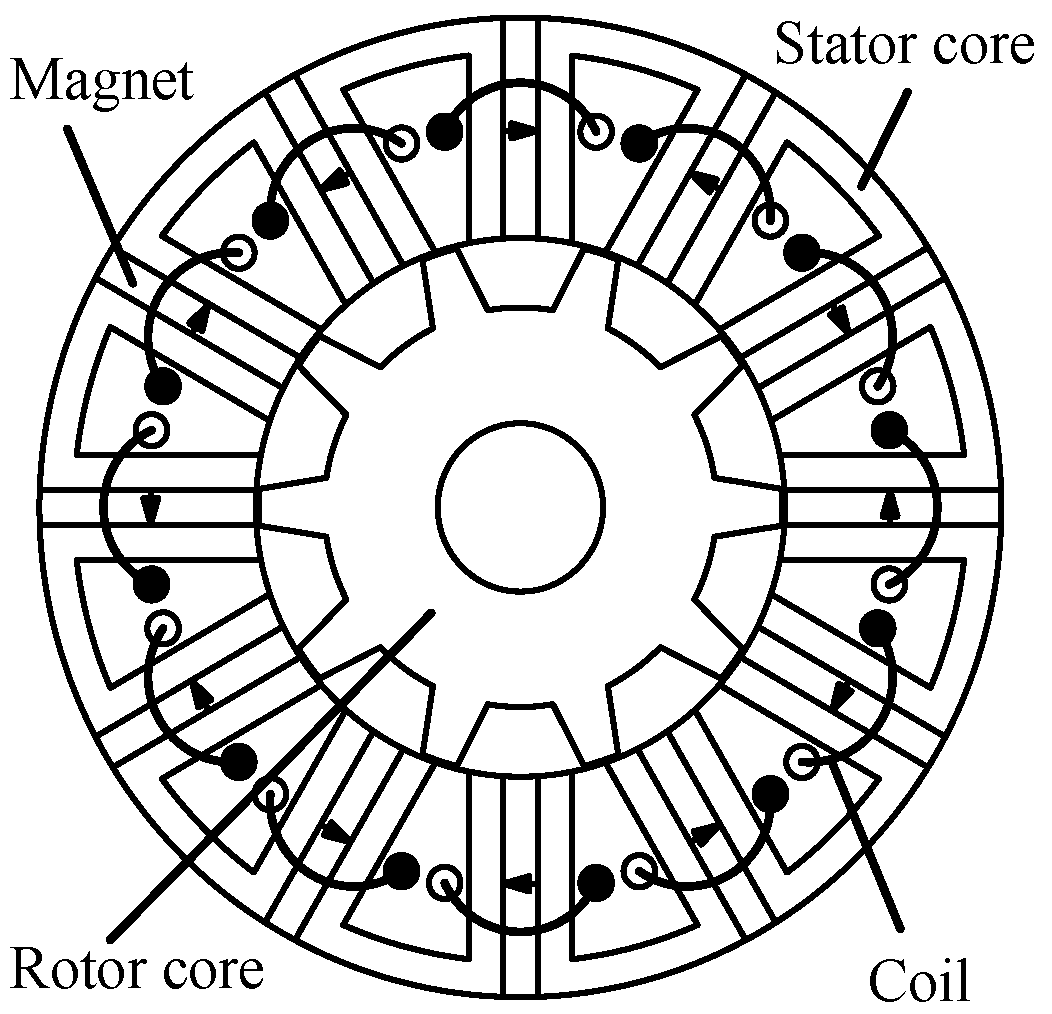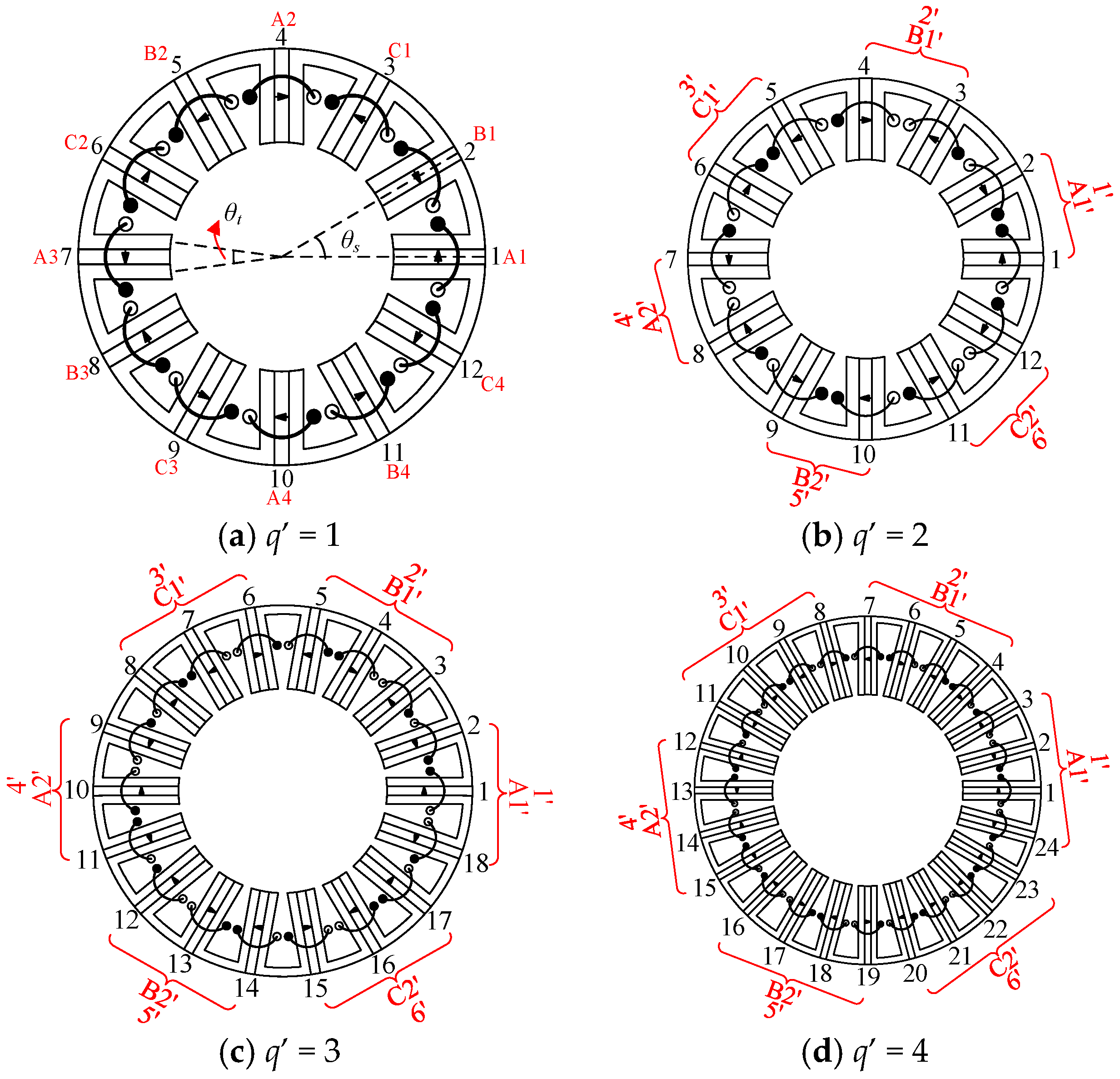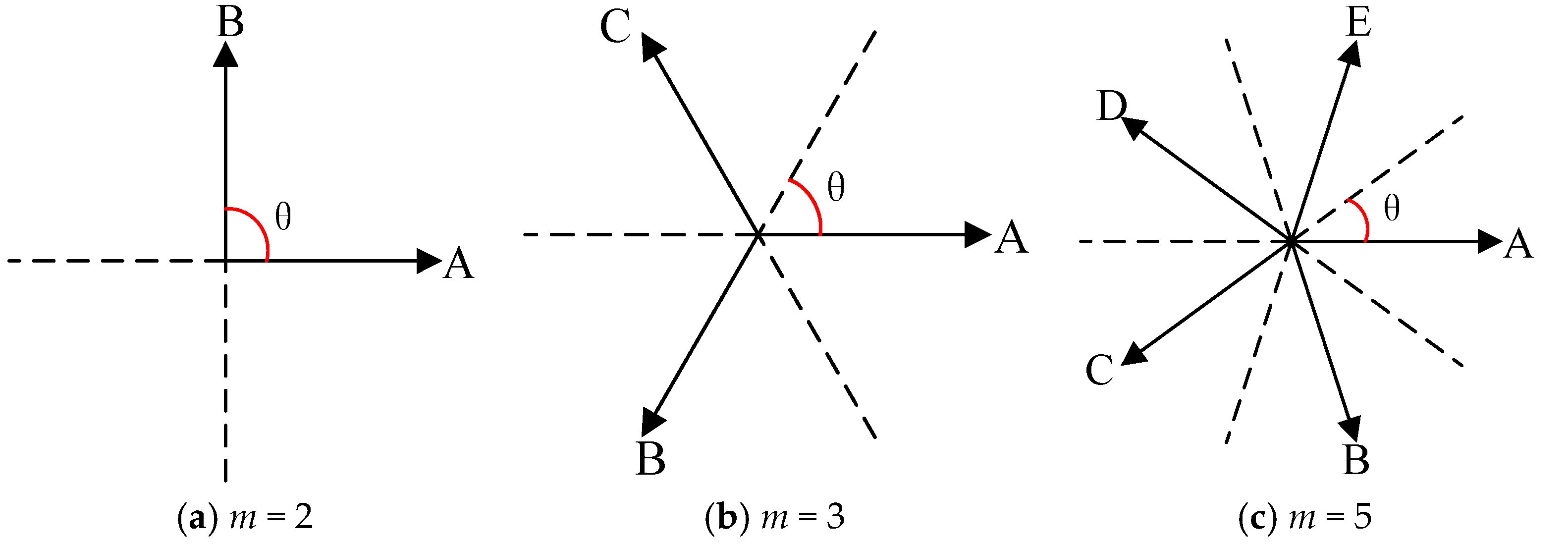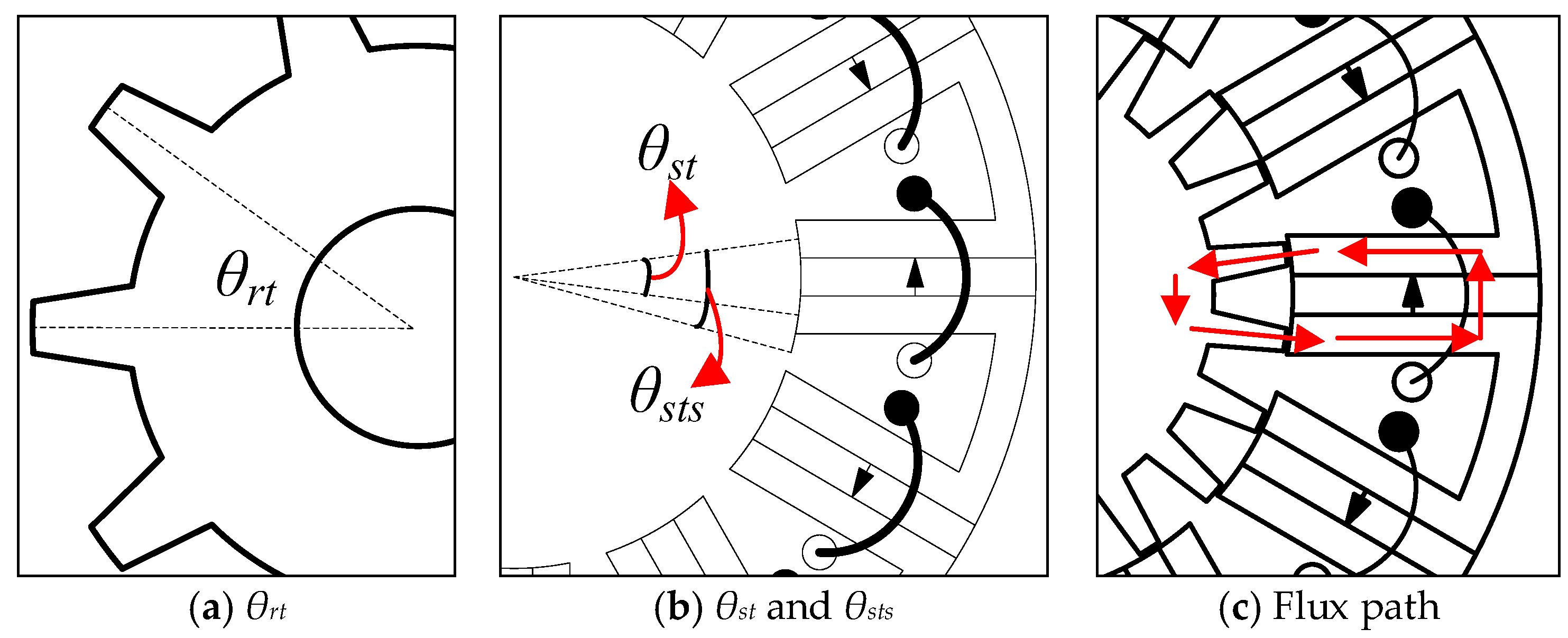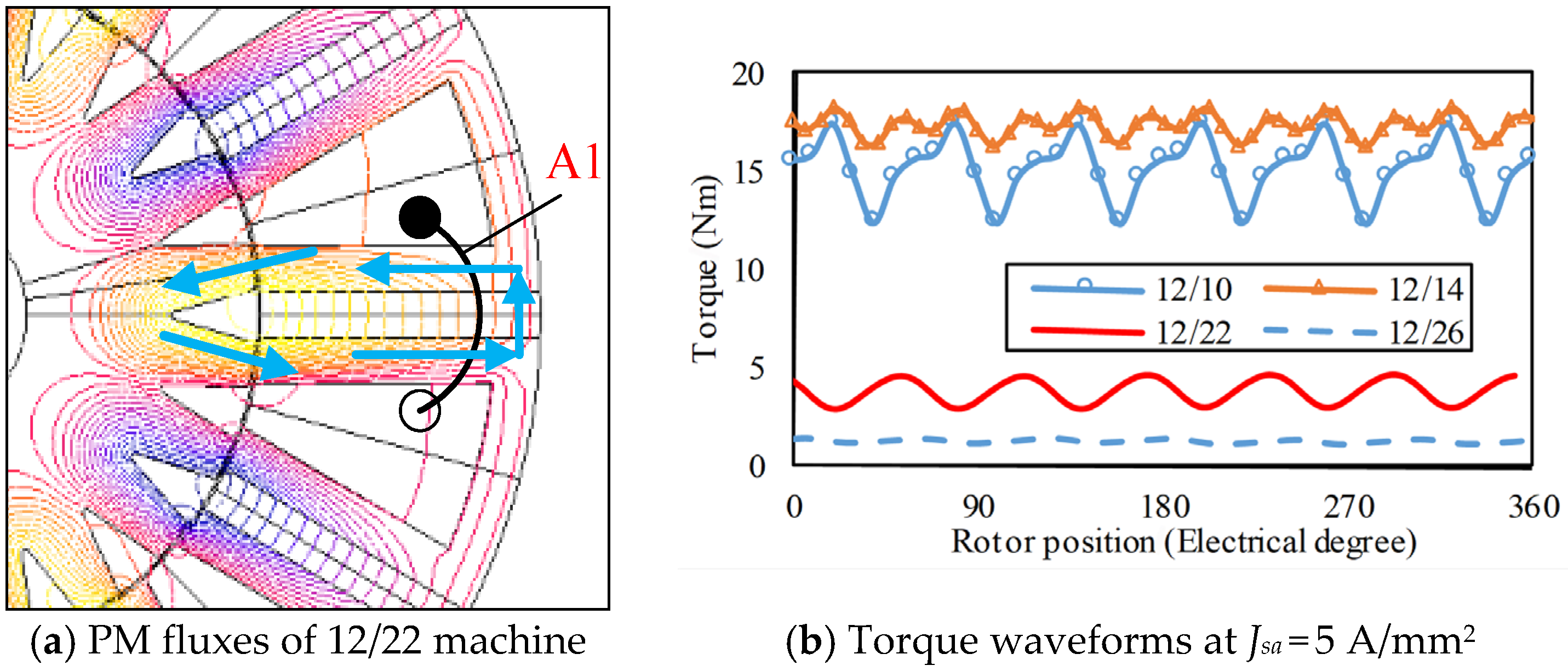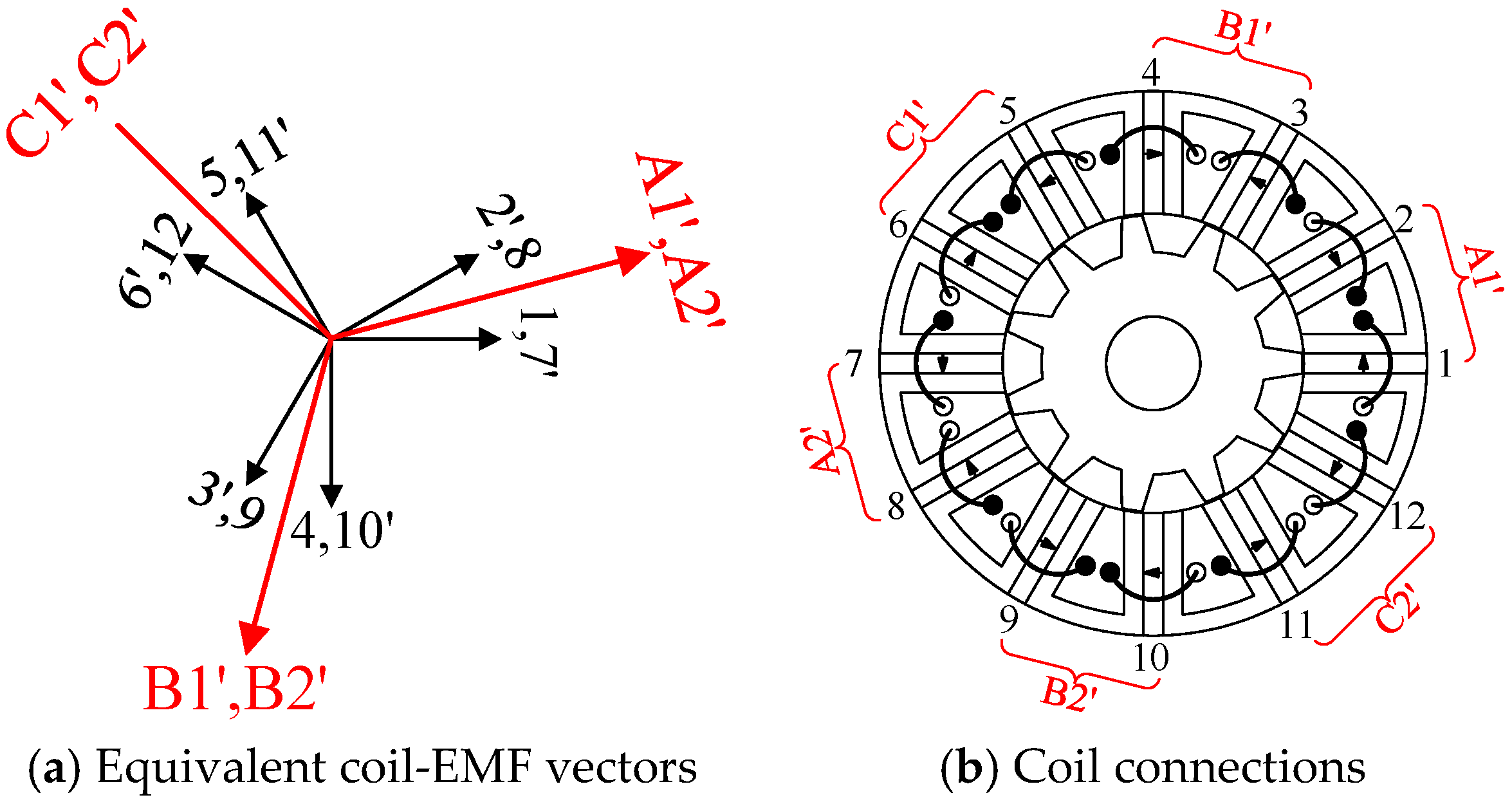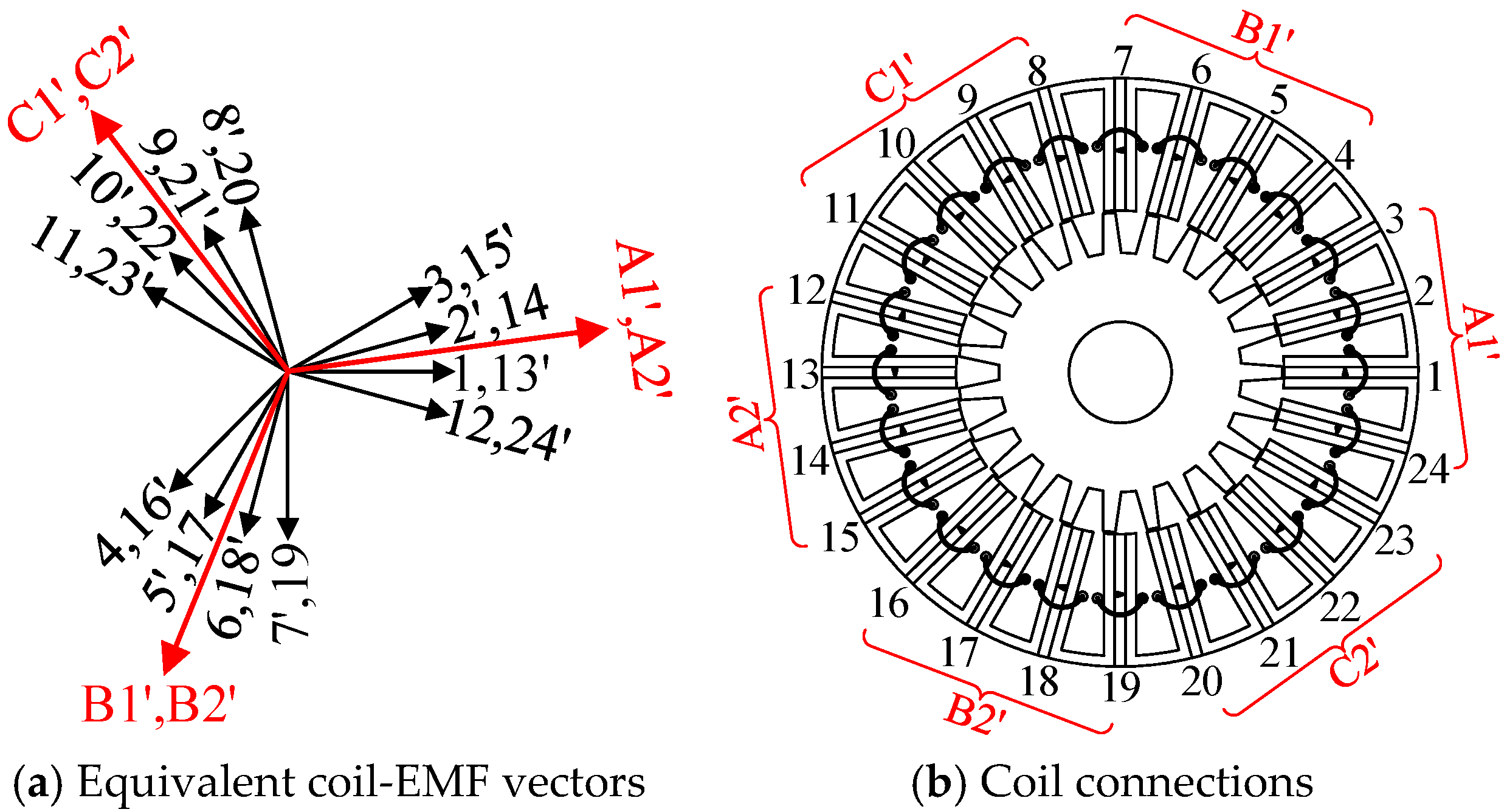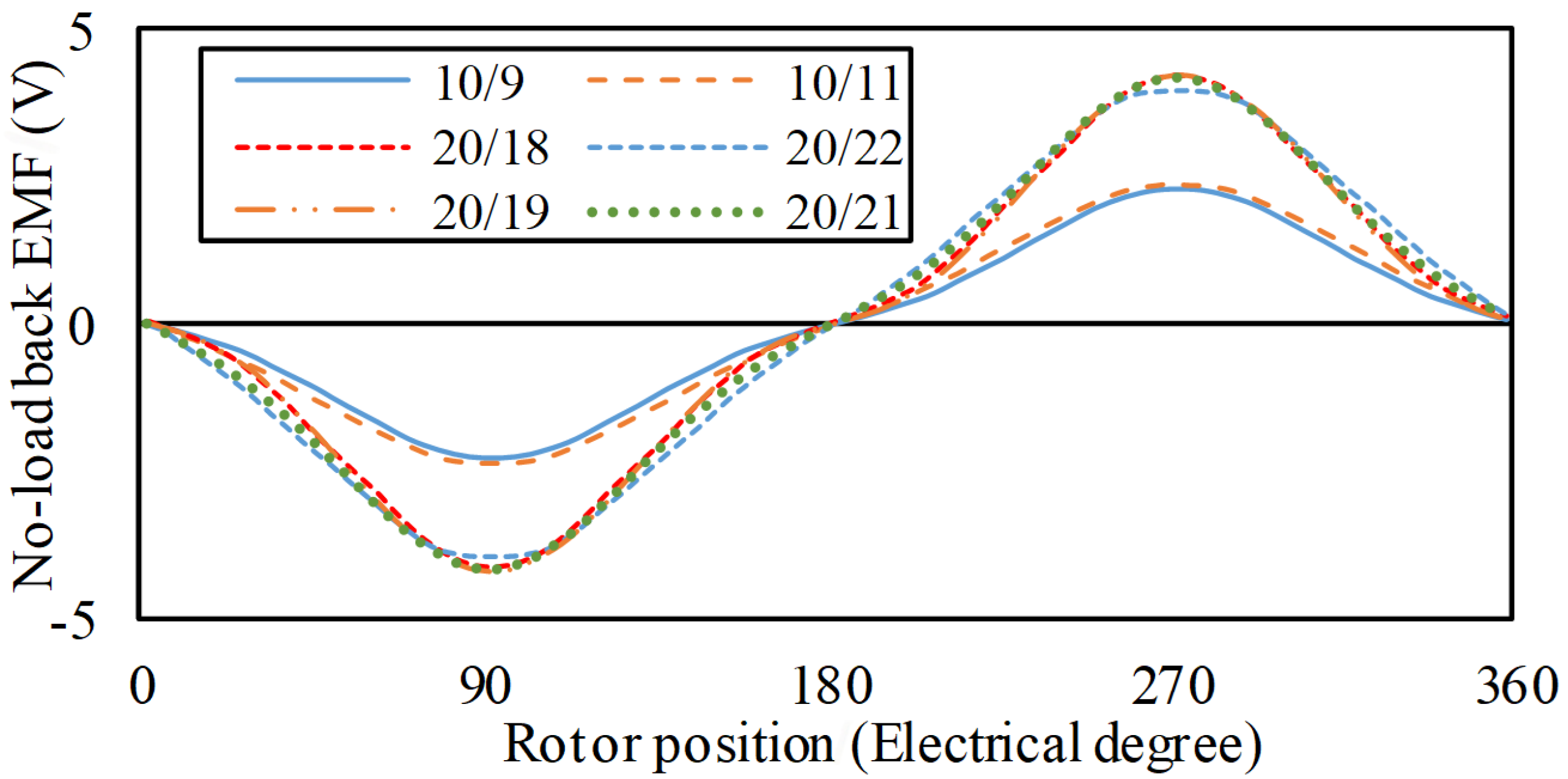1. Introduction
Flux-switching (FS) permanent magnet (FSPM) machines with both magnets and armature windings located on the stator have been investigated in depth since they were reintroduced in 1997 [
1,
2]. And the studies mainly focus on new structures [
3,
4,
5], winding structures [
6,
7], and control strategies [
8,
9]. In conventional FSPM machines, the stator consists of laminated “U”-shaped segments with circumferentially magnetized permanent magnets of alternating polarities placed between them. Each stator pole is composed of two adjacent stator teeth and a piece of magnet sandwiched, as seen in
Figure 1, where a 12-stator poles/10-rotor teeth (12/10) FSPM machine is exampled. These machines are characterized by their “U”-shaped stator iron segments and double-layer concentrated windings, and are named as “conventional FSPM machines” in this paper.
Recently, the operational principles and electromagnetic performance of FSPM machines, focusing on phase PM flux linkage, back electromotive force (EMF), cogging torque, winding inductances, electromagnetic torque, and torque ripple, have been widely and deeply analyzed [
10,
11,
12,
13]. However, as a relatively novel class of electrical machines, the design principles and parameter-determination procedures of FSPM machines are rather insufficient, especially for choosing the rules of the combinations of stator poles and rotor teeth, which limits further studies and applications of this kind of machine. J.T. Chen, and Z.Q. Zhu used an analytical method to evaluate the electromagnetic performance of FSPM machines with different stator pole and rotor teeth combinations, covering from two-phase to six-phase, and the corresponding winding factors of possible combinations were calculated [
14,
15]. The conclusion drawn in [
14] is that the relationship between stator poles (
Ps) and rotor teeth (
Pr) is
Pr =
Ps ± 2 or
Pr =
Ps ± 1, which is definitely helpful for the design of FSPM machines. L. Shao and W. Hua analyzed 12-phase 24/20, 24/22, 24/26, and 24/26 FSPM machines, and found that the 24/26 machine exhibited the highest electromagnetic torque and efficiency, while the 24/22 one had the smallest cogging torque, torque ripple, and efficiency [
16]. H. Chen investigated the effect of winding configurations on the performance of a five-phase outer-rotor FSPM machine, including single-layer, double-layer, and multi-layer winding configurations, and found that the FSPM machine with multi-layer winding exhibited better performance [
17]. X. Zhu and W. Huang analyzed the feasible stator–rotor combination of five-phase FSPM machines considering flux leakage, back electromagnetic force quality, and unbalanced magnetic force [
18]. D. Li, Y. Shi, and J. D. McFarland studied the Air-Gap Field Modulation theory, and then researched the optimal stator–rotor combinations of 6-, 12-, and 18-stator slot FSPM machines [
19,
20,
21].
Despite these advances, there are still several limitations to the conclusions in the existing literature: (1) the investigated combinations are incomplete, such as the cases of Pr = Ps ± 3 (18/15, 18/21) and Pr = Ps ± 4 (24/20, 24/28) for conventional FSPM machines are not considered; (2) for some combinations, e.g., 6/4, 6/8, 18/16, and 18/20, the phase back-EMFs of armature windings are asymmetric because of no complementarity between coils, which are not covered; (3) the nature of “good” and “bad” combinations of stator poles and rotor teeth for conventional FSPM machines is not disclosed; and (4) a general principle to determine the optimal combinations of FSPM machines regardless of phase numbers is not proposed.
To address these gaps, this paper proposes an analytical model to optimize two critical static characteristics based on coil complementarity, namely symmetrical phase back-EMF and large electromagnetic torque. The analytical model enables the general determination of the optimal combinations of stator poles and rotor teeth for FSPM machines with prime phase numbers. Meanwhile, for the FSPM machines with composite phase numbers, such as four, six, nine, and twelve phases, the combinations can be derived from the machines with prime phase numbers. Notably, single-phase FSPM machines are excluded from this series, as the proposed prime phase principles apply to them directly.
The proposed principles are rooted in coil complementarity theory. Therefore, in the following, firstly, the coil complementarity and coil-EMF vectors are introduced and illustrated in
Section 2. Then, a general model that can determine the optimal combinations of stator poles and rotor teeth for conventional FSPM machines with prime phase numbers is proposed and implemented by different examples, including two-phase, three-phase, and five-phase systems, where the predicted electromagnetic performances by 2-D finite element analysis (FEA) verify the feasibility and effectiveness of the general model in
Section 3. Thereafter, in
Section 4, the winding factors of the FSPM machines with prime phase numbers for different stator poles and rotor teeth combinations are calculated and evaluated. Finally, conclusions on stator pole and rotor teeth combination principles for flux-switching brushless machines with prime phase numbers are summarized in
Section 5.
3. Stator Pole and Rotor Teeth Combinations of Conventional FSPM Machines
In this section, combinations of stator poles and rotor teeth for conventional FSPM machines with prime phase numbers, namely two, three, and five phases, are investigated by a model.
3.1. Combinations of Stator Poles and Rotor Teeth Model
From the above analysis, it can be found that the winding connections can be briefly classed into two types, namely,
q′ = 1 and
q′ > 1, according to the number of consecutively adjacent coils belonging to the same phase. For the topologies with
q′ > 1, the consecutively adjacent coils belonging to the same phase are considered as one equivalent coil. The flow chart of the analytical model for stator–rotor combinations is shown in
Figure 5.
3.1.1. q′ = 1
When
q′ = 1, the number of all coils
Psc is exhibited in Equation (8) where
m is the phase number, and
K is the number of coil pairs exhibiting complementarity, which is an integer, e.g., 1, 2, etc. Substituting Equation (8) into (1), the angle between two adjacent armature coils is obtained as Equation (9).
Figure 6 shows the minimum angles between two vectors for the machines with different phase numbers. For two-phase, three-phase, and five-phase machines, the minimum angles are
θ =
π/2,
θ =
π/3, and
θ =
π/5, namely
θ = HCF (2
π/
m,
π), where HCF is the highest common factor. For the topologies with
q′ = 1, the two adjacent armature coils belong to different phase windings, namely, the coil-EMF vectors of two adjacent coils are different. Since the phase angle of the coil-EMF vector for coil 1 is 0°, namely,
θ(1) = 0°, the phase angle of the coil-EMF vector for coil 2, namely
θ(2), should be an integer multiple of the minimum angle
θ, namely satisfying Equation (10). In addition, the phase angle of the coil-EMF vector for coil 2 should not be integer multiples of
π, namely satisfying Equation (11), since it will just constitute a single-phase machine if
θ(2) is an integer multiple of π.
Moreover, it can be seen from
Figure 2b,d, the coils A1 and A2, comprising a coil group, have complementarity, and when one coil aligns with the rotor teeth, the other coil will align with the rotor slot, namely the corresponding rotor positions for coils A1 and A2 are different. Hence, for the machine with
K coil groups,
Pr/
K should be an odd number, namely satisfying Equation (12). Otherwise, the rotor positions corresponding to coils A1 and A2 are the same, resulting in coils A1 and A2 having no complementarity.
Figure 7 exhibits several parameters of the stator and rotor where
θrt is the mechanical angle between two adjacent rotor teeth,
θst is the mechanical angle between two stator teeth of one stator pole, and
θsts is the mechanical angle between the stator tooth and stator slot, which is about 3
θst/2. Three parameters are calculated, shown in Equations (13)–(15), where
Ps =
Psc since each stator pole is wound by a stator coil for conventional FSPM machines. In order to obtain enough electromagnetic torque,
θrt should not be close to
θst and
θrt has to satisfy
θrt ≥
θsts. If
θrt and
θst are close, as shown in
Figure 7c, the PM flux linkage flows into and then flows out of the coil, leading to a smaller effective flux linkage of the armature coil. Taking
q′ = 1 and
m = 3 as an example (
Psc = 12), the 12/10, 12/14, 12/22, and 12/26 FSPM machines all satisfy the Equations (10)–(12). But for 12/22 and 12/26 topologies,
θrt and
θst are quite close; the electromagnetic performances of four machines by FEA are shown in
Figure 8, where the PM flux linkage of coil A1 flows into and then flows out of the coil, leading to a smaller effective flux linkage of coil A1, which causes the torques of the 12/22 and 12/26 machines to be distinctly smaller than those of the 12/10 and 12/14 ones.
In addition, since the machine has
K coil pairs, the number of rotor teeth, namely
Pr, must be bigger than
mK, namely
θrt < 2π/
mK. Hence,
θrt has to satisfy Equation (16). Substituting Equations (13)–(15) into Equation (16), the range of
Pr is obtained as Equation (17).
Through the above analysis, the back-EMF waveforms would be symmetrical if the number of rotor teeth
Pr satisfies Equations (10)–(12) and Equation (17). Therefore, the model determining the stator pole and rotor teeth combinations for conventional FSPM machines with prime phase numbers where
q′ = 1 is shown in Equation (18).
3.1.2. q′ > 1
When
q′ > 1, the adjacent
q′ coils belonging to the same phase are considered as one equivalent coil. Like the machine in
Figure 4b–d, only if the equivalent coils A1′ and A2′ had complementarity could the back-EMF waveforms be symmetrical. Hence, the number of equivalent coils
Psc′ and the mechanical angle of adjacent equivalent coils
θs′ are shown in Equations (19) and (20), where parameter
K is the number of equivalent coil pairs.
For the topologies with
q′ > 1, the two adjacent equivalent coils belong to different phase windings, namely, the coil-EMF vectors of two adjacent equivalent coils are different. Since the phase angle of the coil-EMF vector for equivalent coil 1 is 0°, namely,
θ′(1) = 0°, the phase angle of the coil-EMF vector for coil 2, namely
θ′(2), should be integer multiples of the minimum angle
θ and should not be integer multiples of
π, namely satisfying Equations (21) and (22), which are similar to the topologies with
q′ = 1. Similarly,
Pr is also limited by Equations (12) and (17).
Comparing the equations with
q′ = 1, some other equations need to be added. Firstly, the two adjacent coils in an equivalent coil should be connected in opposite polarity. Since the phase angle of coil 1 is
θ(1) = 0°, the phase angle of coil 2,
θ(2), has to satisfy Equation (23), where
T is an integer number. Taking
q′ = 2 as an example, the two adjacent coils belonging to the same phase will be connected into the opposite polarity shown in
Figure 9a if satisfying Equation (23), and connected into the same polarity in
Figure 9b if not satisfying (23). If the coils are connected in the same polarity, the currents in the stator slot between stator poles 1 and 2 are opposite, which leads to the uselessness of the slot. Secondly, the phase angle of coil 2, namely
θ(2), should be as close to 180° as possible, namely the minimum of cos(
θ(2)), shown in (24), to obtain a larger winding factor.
Through the above analysis, the back-EMF waveforms would be symmetrical and the magnitude of the electromagnetic torque would be large enough if the number of rotor teeth
Pr satisfies the Equations (12), (17), and (21)–(24). Therefore, the model determining the stator pole and rotor teeth combinations for conventional FSPM machines with prime phase numbers where
q′ > 1 is shown in Equation (25).
Based on the models in (18) and (25), the obtained combinations of stator poles and rotor teeth satisfy Equation (26), where it should be noted that the parameter
K is the number of coil pairs exhibiting complementarity for
q′ = 1 and the number of equivalent coil pairs for
q′ > 1.
In the following analysis, the conventional FSPM machines with prime phases, such as two, three, and five phases, are simulated by FEA to verify the conclusion obtained by the above models.
3.2. Three-Phase Conventional FSPM Machines
When
q′ = 1, the stator coil connection is A-B-C-A. Based on the model in Equation (18), when
K = 1, the optimal combinations of stator and rotor poles are 6/5 and 6/7, where the numbers of stator poles and rotor teeth, respectively,
Ps and
Pr, satisfy Equation (26). When
K = 2, the obtained optimal combinations of stator poles and rotor teeth are 12/10 and 12/14, where the parameters
Ps and
Pr also satisfy Equation (26). And 18/15 and 18/21 are the optimal combinations for
K = 3, while 24/24 and 24/28 are for
K = 4. In addition, the parameters
Ps and
Pr satisfy Equation (26). Taking
K = 2 as an example, the coil-EMF vectors and coil connections of the conventional 12/10 machine are listed in
Figure 10.
When
q′ = 2, the stator coil connection is AA-BB-CC-AA. The two adjacent coil-EMF vectors synthesize into an equivalent coil-EMF vector, as shown in
Figure 11a, where
K is the number of equivalent coil pairs. Based on the model in Equation (25), when
K = 1, the optimal combinations of stator poles and rotor teeth are 12/11 and 12/13, where
Ps and
Pr satisfy Formula (26). The combinations 24/22 and 24/26 are the optimal combinations for
K = 2, while 36/33 and 36/39 are for
K = 3, where the parameters
Ps and
Pr both satisfy Formula (26). The coil-EMF vector and coil connections of conventional 12/11 FSPM machines are listed in
Figure 12 as an example.
When
q′ = 3, the stator coil connection is AAA-BBB-CCC-AAA. The three adjacent coil-EMF vectors synthesize into an equivalent coil-EMF vector, as shown in
Figure 11b. Based on the model in Equation (25), when
K = 1, the optimal combinations of stator and rotor poles are 18/17 and 18/19, where
Ps and
Pr satisfy Equation (26). When
K = 2, the obtained optimal combinations are 36/34 and 36/38, where the parameters
Ps and
P also satisfy Equation (26). The coil-EMF vectors and coil connections of conventional 18/17 FSPM machines are listed in
Figure 13.
When
q′ = 4, the stator coil connection is AAAA-BBBB-CCCC-AAAA. The four adjacent coil-EMF vectors synthesize into an equivalent coil-EMF vector, as shown in
Figure 11c. Based on the model in Equation (25), when
K = 1, the optimal combinations of stator poles and rotor teeth are 24/23 and 24/25, whose back-EMF waveforms are symmetrical and sinusoidal. And
Ps and
Pr satisfy Equation (26). When
K = 2, the obtained optimal combinations of stator and rotor poles are 48/46 and 48/50, where the parameters
Ps and
Pr also satisfy Equation (26). The coil-EMF vectors and coil connections of the 24/23 machine are listed in
Figure 14 as an example.
The simulated back-EMF waveforms by FEA of three-phase machines with
q′ = 1,
q′ = 2,
q′ = 3, and
q′ = 4 are, respectively, exhibited in
Figure 15. And a 12/10 prototype and its back-EMF waveforms using a Tektronix oscilloscope are shown in
Figure 15e, which shows that the back-EMF waveforms of the obtained combinations are all symmetrical.
3.3. Two-Phase Conventional FSPM Machines
The models shown in Equations (18) and (25) are also suitable for two-phase machines. When q′ = 1, based on the model in Formula (18), the available configurations are 4/3 and 4/5 for K = 1, 8/6 and 8/10 for K = 2, and 12/9 and 12/15 for K = 3, which match with Equation (26). When q′ > 1, based on the model in Equation (25), the available configurations also match with Equation (26), for example, configurations 8/7 and 8/9 are suitable for q′ = 2 and K = 1, and configurations 16/14 and 16/18 are suitable for q′ = 2 and K = 2.
As is shown in
Figure 16, the FE-predicted back-EMF waveforms of the conventional two-phase topologies with
q′ = 1, namely, 4/3, 4/5, 8/6, and 8/10, and topologies with
q′ = 2, namely, 8/7 and 8/10, are all symmetrical.
3.4. Five-Phase Conventional FSPM Machines
For five-phase conventional machines, the models (18) and (25) are also useful to determine the optimal stator pole and rotor teeth combinations. When q′ = 1 and K = 1, based on the model in Equation (18), the configurations 10/7, 10/9, 10/11, and 10/17 are obtained, whose back-EMFs are all symmetrical. Hence, for five-phase machines, more than two combinations have symmetrical back-EMF waveforms, whereas for two- and three-phase topologies, only two combinations have symmetrical back-EMF waveforms. Since the torque is larger when Pr is close to Ps, the configurations 10/9 and 10/11 are the most optimal stator and rotor pole combinations, which satisfy Formula (26). Similarly, when q′ = 1 and K = 2, the optimal stator pole and rotor teeth combinations are 20/18 and 20/22, which also satisfy Equation (26). When q′ = 2, the optimal stator pole and rotor teeth combinations are 20/19 and 20/21 for K = 1, and 40/38 and 40/42 for K = 2, which also satisfy Equation (26).
The five-phase topologies with
q′ = 1 covering 10/9, 10/11, 20/18, and 20/22, and topologies with
q′ = 2 including 20/19 and 20/21, are investigated by FEA. And the predicted back-EMF waveforms shown in
Figure 17 are all symmetrical.
It can be distinctly seen from the above FE-predicted results that the conventional FSPM topologies with prime phase numbers, whose stator pole and rotor teeth combinations are determined by the proposed models, satisfy Pr = Ps ± K and exhibit symmetrical back-EMF waveforms, which illustrate the validity of the models.
4. Winding Factors
Winding factors include the distribution factor and pitch factor. The distribution factor
kd is given in papers [
14,
22]:
where
Q is the number of the fewest EMF vectors per phase,
α is the angle between two adjacent vectors, and
v is the order of the harmonic. The parameter
α is given in Equation (28), and
m is the phase number for prime phase machines.
For the prime phase,
Q =
q′. And finally, the distribution factor
kd is expressed as Equation (29).
The pitch factor
kp can be calculated as follows:
where
Ps =
Psc = 2
mKq′ for conventional FSPM machines.
Therefore, the winding factor
kw can be given as follows.
Equation (31) illustrates that for conventional FSPM machines with prime phase numbers, the fundamental winding factors are just related to the parameters of
m and
q′. And the winding factors are calculated and listed in
Appendix A, covering two-, three-, and five-phase machines.
5. Conclusions
In this paper, firstly, to obtain the symmetrical back-EMF, a general model for determining the optimal stator pole and rotor teeth combinations of conventional FSPM machines with prime phase numbers, namely, two-, three-, and five-phase machines, is established. The concluded relationship between the stator poles and rotor teeth is Pr = Ps ± K. Then, the FE-predicted results of the conventional FSPM machines, whose stator pole and rotor teeth combinations are determined by the proposed models, are all symmetrical, verifying the effectiveness of the proposed models. Afterwards, the winding factors of the conventional FSPM machines with prime phases and different combinations of stator poles and rotor teeth are calculated.
In this paper, the stator pole and rotor teeth combinations of the conventional FSPM machines with prime phase numbers are determined by the proposed models based on coil complementarity. However, for the conventional FSPM machines with composite phase numbers, four-, six-, nine-, twelve-phase machines, etc., the optimal stator pole and rotor teeth combinations of them cannot be obtained by the models proposed in this paper, but they can be deduced from the results of the machines with prime phase numbers.
